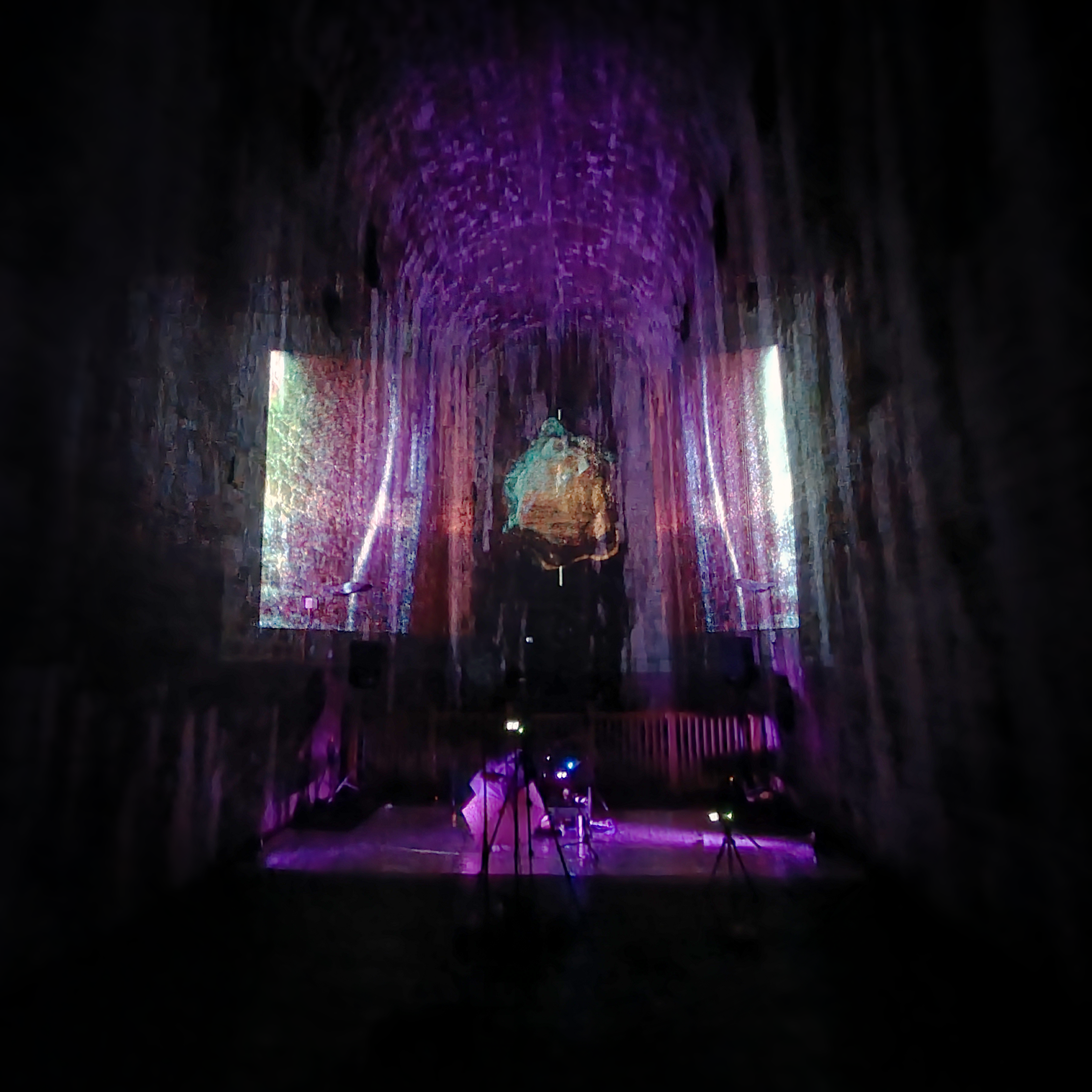Sedimentary Stone Tape

Description
 Sedimentary Stone Tape was a performance by the Manchester-based artist Kelly Jane Jones, commisioned by Bristol New Music in 2022. It was a site-specific multimedia performance within the mysterious and rarely-used vault deep beneath Bristol’s iconic Clifton Suspension Bridge.
Sedimentary Stone Tape was a performance by the Manchester-based artist Kelly Jane Jones, commisioned by Bristol New Music in 2022. It was a site-specific multimedia performance within the mysterious and rarely-used vault deep beneath Bristol’s iconic Clifton Suspension Bridge.
"Artist Kelly Jane Jones creates a new performance for intimate groups, retrieving deep time resonances from the rock in a vaulted chamber long hidden under Clifton Suspension Bridge, including film work by Kevin Craig." - Headfirst
The performance included a mixture of percussion, singing bowls, voice, flute and rock textures. All enhanced through electronics and spatialised through a quadraphonic speaker array. I was approached to record a performance for Kelly and Bristol New Music, and used this opportunity to explore a range of presentation formats, including, video, audio only (binaural, Ambisonic, Dolby Atmos) and VR with LiDAR derived scenary. This was a continuation of my aesthetic and work with sound and LiDAR in VR from Brixham Immersed. I was assisted by Isaac Romano Espinaco in the audio recording and Oliver Davey in the LiDAR capture. The project also made use of Higher Order Ambisonic Room Impulse Response map of the vault to post-produce a controlled acoustic of the space using the performance recording.
Audio
Recording
 The recording strategy was made with the intention of a VR version with Impulse Responses from the offset. This would require close mic sound sources and clean feeds from the loudspeakers in addition to room microphones and an appropriate selection of Ambisonic Room Impulse Responses (ARIRs).
The recording strategy was made with the intention of a VR version with Impulse Responses from the offset. This would require close mic sound sources and clean feeds from the loudspeakers in addition to room microphones and an appropriate selection of Ambisonic Room Impulse Responses (ARIRs).
DPA 4006C were used as close mic options to give a natural sound at proximity in a small form factor for both the table where Kelly would perform most of the show and in her stood position for the flute section. XLR splitters were used to interrupt the loudspeaker feeds. An additional faux-binaural OSS Schneider disk with earthworks M40 mics would provide a static binaural reference of the room which wasn't used in practice. These 8 channels would go into a Zoom F8 field recorder.
In an additional Zoom F8 recorder, was a Core Octomic AA-Format (2nd order ambisonic) placed in the centre position. This would capture the room spatially and be used as the main reference mic in postproduction. The two recorders used Time Of Day timecode and were jam-synced together in preparation. An additional clap and call by Kelly during recording would provide a sync point on all mics and indicated fine delay between the recorders for alignment in mixing.
Ambisonic Room Impulse Responses
A week after recording I returned to the vaults with Oliver Davey to capture the LiDAR scans and ARIRs. While chirps and sweeps are often favoured for IR capture these require large loudspeakers, computers and power concerns to operate. The vaults beneath the bridge can only be accessed via pulley and ladder system and with the few hours afforded by the bridge custodial team this kind of set-up would be too complex and cumbersome. From previous experiments with IRs derived from sweeps I often find they sound too much like the loudspeaker in question. For this reason we used balloon pops as an equvilent. There are studies that indicate that the repeatability and spectral shape of balloon derived IRs are fairly consistent (Gomez-Agustina & Vazquez-Barrera, 2020) so long as the size, position and inflation amount are consistent (Pätynen et al., 2011). The editing of Balloon IRs for use in convolution reverbs are also very easy and lack the correlation and denoising steps required from sweep derived IRs.
The location of each sound source from the recording was mapped out on the floor and impulses were recorded usng the Core Octomic and Zoom F8 Field Recorder once more. Multiple takes were captured and later the mic positions were moved to the side walls, corner and rear wall to capture the difference in acoustic near to reflective surfaces of the vault.
Mixing

Video
The video capture was not intended to be a main feature of the record and was a safety net in case the VR production couldn't go ahead. It was filmed on a pair of Canon XA11 camcorders one of which shot in Infrared to provide some better clarity in the low light conditions. The second camcorder was shot in portrait orientation to capture the height of the vault. In editing these two positions were combined into a portrait layout. A fixed stereo binaural render of the mix was synchronised and muxed into the video file.